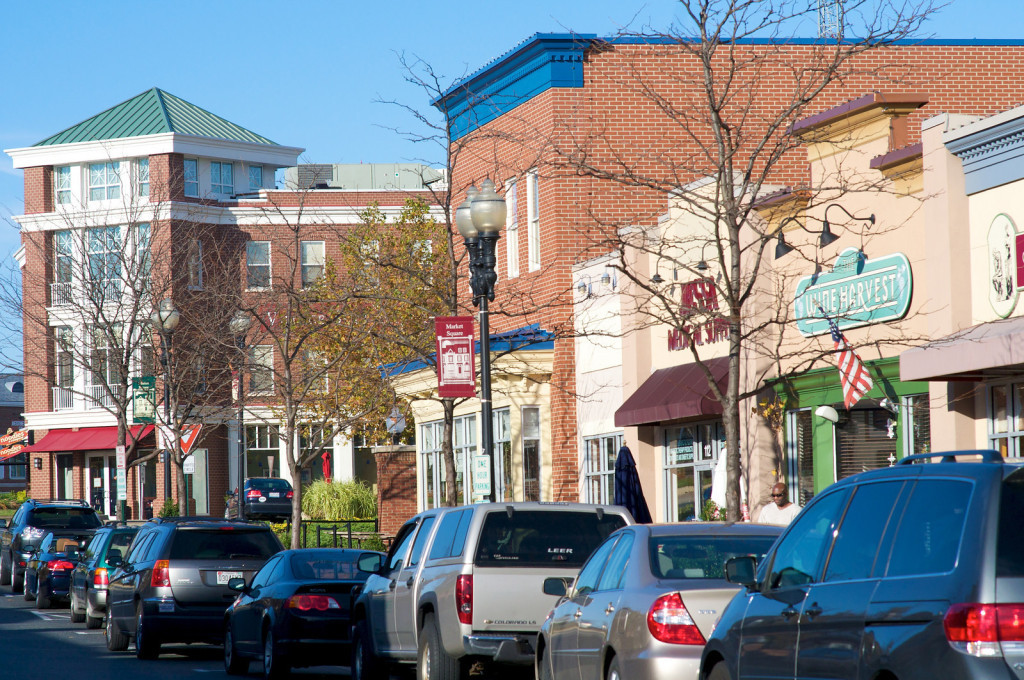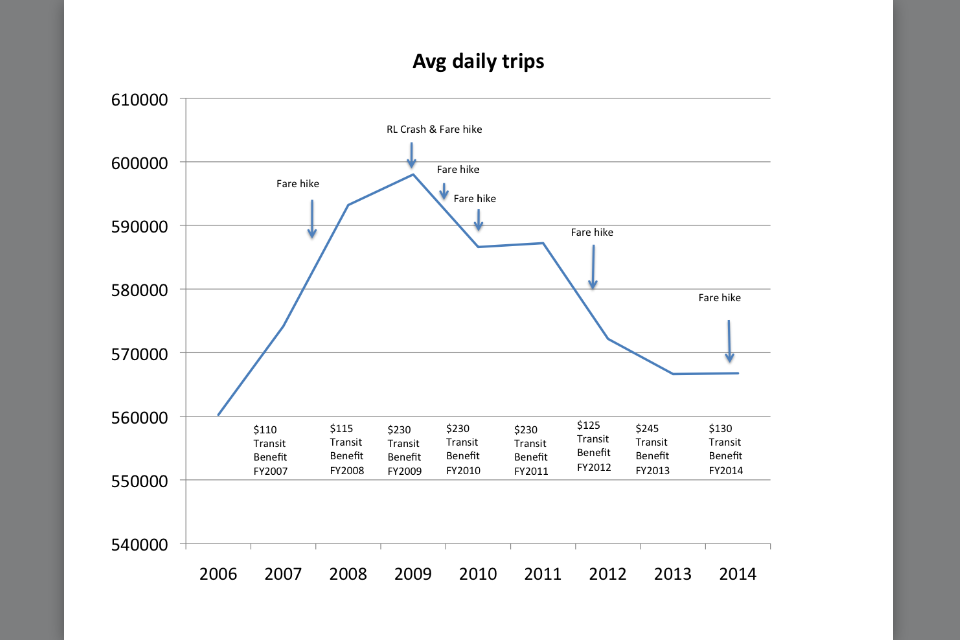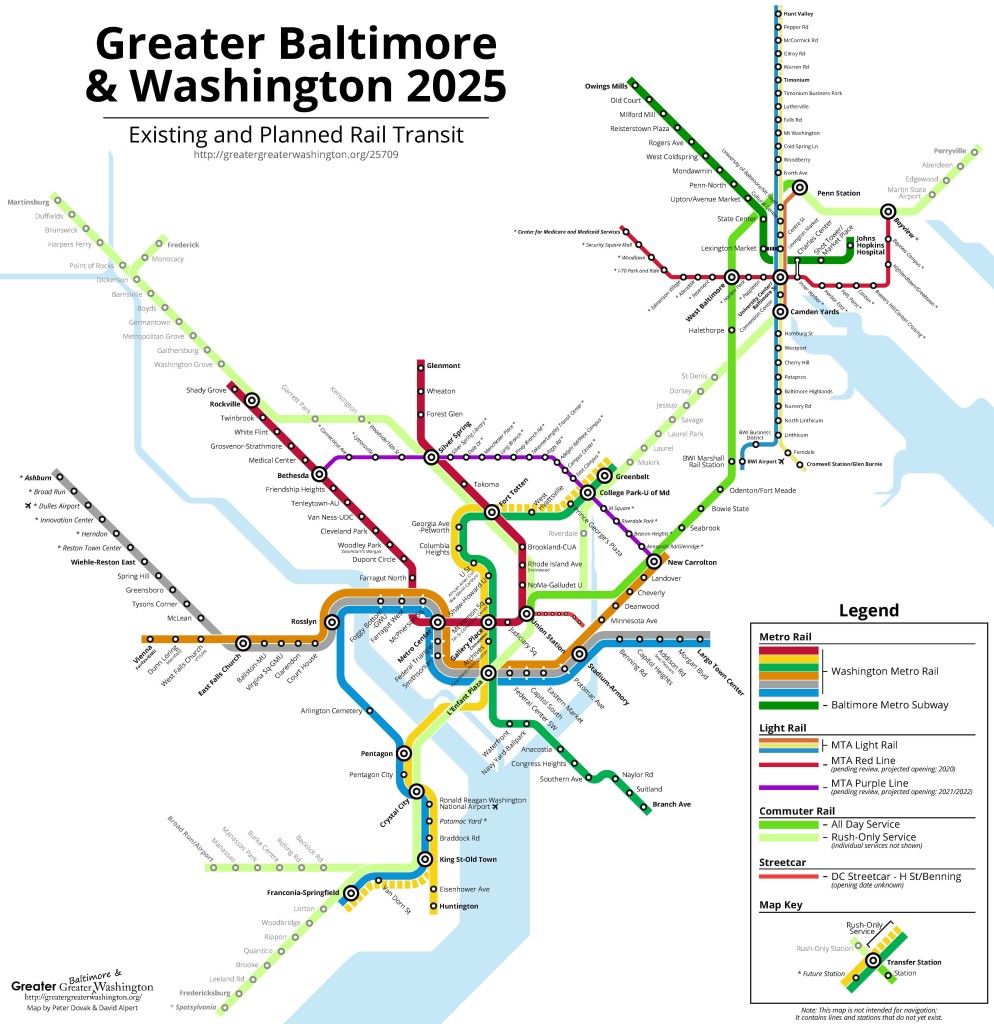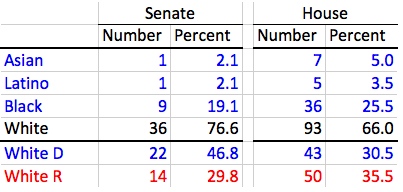Downtown in the Kentlands–a Succssful Example of New Urbanism in Montgomery County
Part I (“They’ve Come Undone”) in this series overviewed the area’s recent rejection of several pricey transit projects. Part II (“Why has the GGW Agenda Stalled”) began to explain why, focusing on their high cost and Metro’s ills. Today, I look at the disconnect between Greater Greater Washington’s vision for high-density transit-oriented development and the new urbanism that has been embraced by many suburbanites.
The reaction against suburban sprawl, well-detailed in Suburban Nation: The Rise of Sprawl and the Decline of the American Dream, led to many thoughtful efforts on how to build more workable communities and the new urbanism movement.
Despite its many excellent contributions–and they are numerous–Greater Greater Washington’s (GGW) more extreme vision that ultimately rejects less dense versions like the Kentlands shown above have helped undercut support for its agenda for expensive light-rail and streetcar projects.
The American Dream
The ideal for most American families is not a Manhattan apartment but remains a single-family residence with a yard. Parents still envision their kids playing in the yard rather than running down to Busboys and Poets.
That home doesn’t necessarily have to be on the type of large lot associated with suburban sprawl. For many, the dream can be a townhouse, as long as they still have their own piece of grass to call their own and hold barbecues. Even people who move back into central cities often choose these sorts of homes over new apartments.
Urban Living is Expensive
Many people who like the urban dream, however, still have trouble realizing it. Precisely because it is desirable for reasons oft-outlined by GGW, they cannot afford it. It’s an unavoidable consequence of the very success of areas like Bethesda and Silver Spring.
This trend only accelerates as urban areas develop and become more sought after. The addition of many new apartment buildings in Silver Spring and Bethesda has not made either place a bargain. Moreover, it encourages renovation of older, more affordable housing into more expensive units.
Additionally, apartments and close-in townhomes are often more expensive than single-family homes due to the condo fees that go with them. Even if the price to buy is cheaper, condo fees can render the monthly cost unaffordable. And condo fees aren’t tax deductible and don’t go towards acquiring an asset like mortgage payments. A friend recently explained to me that this is why he couldn’t and didn’t move into downtown Wheaton.
GGW is aware of these problems and laments them but does not get that the high cost an inevitable part of the project. Indeed, from the perspectives of governments that support transit-oriented growth, it is the central point because higher land values and high-income residents provide more tax revenues.
Residents often do understand, which is why they some are resistant to new transit-oriented development even as others are excited. Renters rightly sense that they are going to have to move eventually. Small business owners will find commercial rents too high as the area catches fire. Homeowners worry that their taxes will increase along with home value–and the former matters a lot if you’d like to stay in your home awhile.
The Kentlands Vision of New Urbanism
The urban vision exemplified by the Kentlands–one of the earlier new urbanist developments–has proved very attractive to suburbanites. Central to this vision was to make suburban living a more community-oriented experience by taking what worked in older towns and applying it to the suburbs.
Density should be highest closer to the central shopping area but decline as you move away from the center to town homes and then close together single-member homes. Instead of dead-end cul-de-sacs that feed into a single artery, there is a more natural old-style town traffic plan.
Streets are tighter, which gives a more neighborly feel and slows down drivers–much like in Chevy Chase or Kensington. Garages are given less pride of place. The central shopping area or “downtown” provides people quick access to the necessities.
Other developments similar to the Kentlands have proven very popular in Montgomery. Unlike the Kentlands, several have the potential to be linked to transit, which should only increase their livability–good for residents–and desirability–good for the tax base.
Greater Greater Washington Rejects the Kentlands
Despite grudgingly acknowledging some positive aspects of the Kentlands, Greater Greater Washington is fundamentally less keen, envisioning much more dense developments with few, if any, single-family homes.
GGW attacked the Montgomery County Council’s decision to appoint the Kentlands developer over Ben Ross, one of its own contributors and former head of the Action Committee for Transit (ACT). Ben Ross is critical of single-family homeowners in extreme terms that led councilmembers to repudiate his book:
A major obstacle, he says, is the resolve of owners of single-family homes to preserve “their privileged place in the residential pecking order.”
Probably not the way most Montgomery residents would like their Planning Board or County Council to view them. In another post, GGW writer Dan Reed takes Suburban Nation author Andres Duany to task and attacks new towns like the Kentlands for lacking diversity and being too affluent:
Despite having everything from one-room granny flats to million-dollar mansions, it’s still a homogeneous, affluent, predominantly white place. And now, twenty years later, much of D.C. is starting to look like Kentlands.
Again, the movement of high income, often but not necessarily white, residents into areas like Silver Spring and Washington is the intended result of the urban transit policies, not an accidental or surprising byproduct.
Make no mistake, GGW thinks developments like the Kentlands are better than traditional suburban sprawl. But, at heart, they view them as second rate. Dan Reed labels them “compared to places like DC, Arlington, or Silver Spring, they are relatively isolated, homogeneous, and car-dependent.”
At best, as one of his GGW co-bloggers writes, the Kentlands can be some sort of gateway drug to embracing true urbanism:
Thus, in a twist of fate, new urbanism’s main lasting benefit may be that it’s a gateway for suburbanites to become urbanites
— a baby step towards regular urbanism. A necessary step, to be sure, but one quickly passed by.
The problem for GGW is that most people in Montgomery, Prince George’s, and Fairfax live in suburban developments and will continue to do so. Though it may shock GGW, they even like them and are proud of their homes–just like people in the city.
It is difficult enough to convince residents of neighborhoods who will not benefit from these very expensive transit lines to pay for them since they will not ease traffic and they will take away money from their transportation needs. Explanations that berate people for being affluent or privileged (read: almost all of Montgomery County) for making different choices than the GGW high-rise dream will hardly facilitate it.





